
|

|
|
Home Site Search Contact Us Subscribe
|
|
Book Review: "Saint John's Abbey Church: Marcel Breuer and the Creation of a Modern Sacred Space," by Victoria M. Young A history of the making of a contemporary sacred architectural masterpiece transcends its subject and becomes a broadly applicable study of peerless client-architect communication. By Norman Weinstein December 19, 2014 In Theology in Stone: Church Architecture from Byzantium to Berkeley, a valuable and largely solemn overview of sacred architecture penned by Richard Kieckhefer, the author permits himself one lighthearted moment. Playing with the title of Tom Wolfe’s From Bauhaus to Our House, Kieckhefer’s jests that someone should write a book on Modernism’s impact on sacred architecture entitled, “From Bauhaus to God’s House.”
Uncannily, that is precisely what professor of modern architectural history Victoria M. Young has done in Saint John’s Abbey Church: Marcel Breuer and the Creation of a Modern Sacred Space (University of Minnesota Press, 2014), a towering history of Breuer’s Bauhaus-influenced design of the church. One can only regret that Young’s book is saddled with an academically dry title with none of Kieckhefer’s or Wolfe’s wit. But that is easily overlooked when considering how Young’s book dazzles as an illuminating story of a critical episode in church architectural history, replete with lessons for architects in the present.
Here are the essential elements of Young’s story. The brethren at the Benedictine Abbey of Saint John the Baptist in Collegeville , Minnesota, during the 1950s seek to expand their campus. The impetus for this expansion? A desire to have their campus mirror changes in the Catholic liturgy, the orders of devotion codified in speech, song, and lifestyle. The center of this expansion was a new church. In aligning with the liberalizing spirit of the Catholic Church of that era, the Benedictines (known historically for their hospitality to those outside of their fold as well as within the church) requested proposals from an impressive range of globally honored architects, some with previous church design experience, some not; some Catholic; some not religious at all. What cohered the list of would-be architects that included Richard Neutra, Eero Saarinen, Walter Gropius, and Marcel Breuer, was a thoroughgoing commitment to Modernism, the spirit of “make it new.” The choice by the Benedictines of Marcel Breuer was daring. Breuer’s background was centered in the Bauhaus. He had never designed a church – and was not a Catholic, so lacked familiarity through intimate contact with both Catholic liturgy and architecture.
What occurred was an extraordinary educational process propelled by how the architect taught design to Benedictine monks, and how they, in turn, taught the architect what kinds of space and light would best meet their devotional needs. As Young succinctly summarized this process: “. . .the success of the project is the direct result of a marriage between a talented architect and a client with a clear and focused vision.” What impresses throughout Young’s riveting telling of this “marriage” is how architect and client worked in a delicate yet energetic balance to co-create a complex vision. Breuer and his talented staff were tasked with the challenge of creating an innovative materialization of an ancient spiritual vision rooted intensely in invisibilities. Prayer, study, and work were the monk’s daily visible occupations. What role could innovative architecture play in their lives unified by such seemingly timeless pursuits?
Through critical listening and careful/caring assertion in talk and writing over years, through a commitment to geometric rigor charged with ancient spiritual symbolism, and through a near-religious devotion to sculptural design possibilities inherent in concrete, Breuer and his team, in remarkable harmony with his Benedictine client, created a masterwork that seems as “modern” in 2014 as it did at the time of its completion in 1961, and acclaim for the building from architects and scholars, as well as the general public, shows no signs of letting up after a half-century. Peruse the community’s website for a sense of what the excitement about Saint John’s Abbey Church is all about.
Now what lessons might Young’s book hold for architects who may never be involved with sacred architecture? First, much of this project’s success can be attributed to Breuer’s capacity to learn the most subtle meanings of functionalism from his client. What “works” for monks – acutely demanding and unconventional clients – are spaces inviting contemplation and prayer. This is a tall order for any architect since so much secular architecture addresses the action-driven practical needs of clients. Making even more complex the architect’s challenge in designing sacred architecture are the necessarily thick layers of symbolic and metaphoric meaning that need to be embedded in design. Yet all the various demands of both sacred and secular-focused clients share the need for an intellectually robust design dialogue in which client values and designer values find common ground through the development of a lingua franca.
With the astuteness that only a superior architectural historian could marshal, Young moves us through critical passages in the design dialogue between Breuer and the Benedictines. A close reading reveals how obstacles in understanding were overcome through reason, patience, and joint fervid devotion to concrete (pun intended) beauty. The art of Saint John’s Abbey Church reflects with utter refinement the art of architect-client dialogue raised to the highest power. This book should be required reading in every architecture school. At the very least, it warrants being noted as the first great architectural history of the 21st century. And maybe if that recognition happens, The University of Minnesota Press will reissue it in paperback as “From Bauhaus to God’s House”?
Norman Weinstein writes about architecture and design for Architectural Record, and is the author of “Words That Build” – an exclusive 21-part series published by ArchNewsNow.com – that focuses on the overlooked foundations of architecture: oral and written communication. He consults with architects and engineers interested in communicating more profitably; his webinars are available from ExecSense. He can be reached at nweinstein@q.com.
More by Weinstein:
An exclusive 21-part series that focuses on the overlooked foundations of architecture: oral and written communication.
Weinstein: From Ada to Zaha and Everything In Between Op-eds, book reviews, musings, and debate.
Upcoming East Coast book events with Victoria M. Young:
Monday, January 26, 2015 More info here: http://www.upress.umn.edu/press/events/victoria-m-young-talk-in-washington-dc
|
(click on pictures to enlarge) 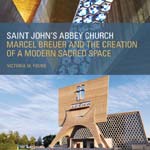 University of Minnesota Press
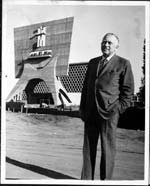 Courtesy of Saint John's Abbey Archives Marcel Breuer at Saint John's Abbey.  Courtesy of Olga Ivanova The church's interior provides a new setting for the Catholic liturgy. 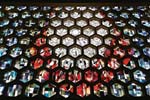 Courtesy of Olga Ivanova The central, white portion of the northern stained glass window symbolizes the eye of God. 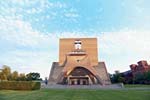 Courtesy of Olga Ivanova Traditional and modern: the churches of Saint John's. 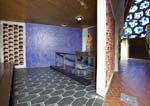 Courtesy of Olga Ivanova The Lady Chapel, featuring a 12th-century Burgundian wooden sculpture of the Madonna and Child, shows how materials can become decoration. |
© 2014 ArchNewsNow.com